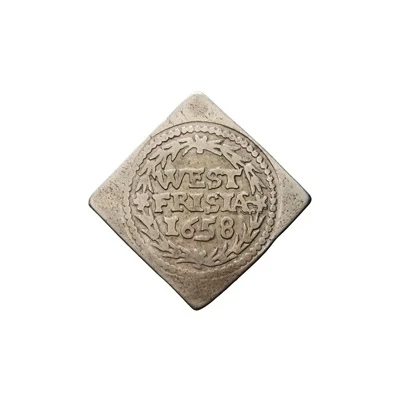


© Koninklijke Nederlandse Munt
1 Duit
| Silver | 6.33 g | - |
| Issuer | region of West Friesland (Dutch Republic) |
|---|---|
| Type | Standard circulation coin |
| Years | 1626-1665 |
| Value | 1 Duit (1⁄160) |
| Currency | Gulden (1581-1795) |
| Composition | Silver |
| Weight | 6.33 g |
| Shape | Round |
| Technique | Klippe |
| Orientation | Medal alignment ↑↑ |
| Demonetized | Yes |
| Updated | 2024-10-06 |
| Numista | N#53924 |
|---|---|
| Rarity index | 100% |
Reverse
Crowned arms of West Frisia
Script: Latin
Lettering: DEVS. FORTI. ET. SP. NOS
Unabridged legend: Deus fortitudo et spes nostra
Translation: God is our strength and hope.
Comment
As a normal duit would be both round and from copper, the intrinsic value of this coins was far more than a duit (weight > 1/2 gulden) and it was only made as a kind of proof coinage for mint-officials (the same applies for gold versions of silver coinage).Interesting fact
The 1 Duit coin from West Friesland (Dutch Republic) was minted during a time of great economic and cultural significance for the region. The Dutch Republic was a powerful trading nation during the 17th century, and the city of Amsterdam was one of the wealthiest and most influential cities in Europe. The West Friesland region, where this coin was minted, was an important center for trade and commerce, and the 1 Duit coin was likely used in many transactions during this time. It's also worth noting that the coin's design features a unique combination of symbols and letters that reflect the cultural and political influences of the time. The coin's obverse side features a portrait of a bearded man, believed to be a representation of the Dutch Republic's founder, William the Silent. The reverse side features the coat of arms of West Friesland, which includes a shield with three horizontal stripes and a crown on top. The letters "W" and "F" are also visible on the coin, representing the region of West Friesland. Overall, this coin is not only a valuable collector's item but also a fascinating piece of history that offers a glimpse into the economic, cultural, and political landscape of the Dutch Republic during the 17th century.



